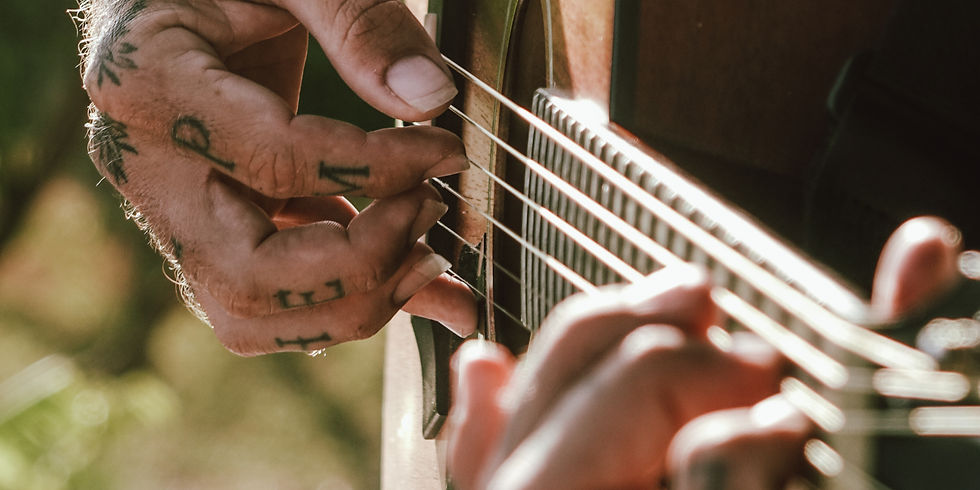What Are Arpeggios?
- Jul 16, 2024
- 3 min read
Updated: Jul 28

Arpeggios are a fundamental musical concept that every guitarist should understand and master. They add a beautiful, flowing quality to music and are essential for both rhythm and lead playing. But what exactly are arpeggios, and how can you incorporate them into your playing? Let's dive into the world of arpeggios and explore their magic.
Understanding Arpeggios
An arpeggio, often referred to as a "broken chord," is a sequence of notes from a chord played individually in succession, rather than simultaneously. Instead of strumming all the strings at once, you pick each note of the chord one after the other. This creates a more melodic and intricate sound compared to playing the chord as a whole.
The Structure of Arpeggios
Arpeggios are built from the same notes as chords. For example, a C major chord consists of the notes C, E, and G. An arpeggio of a C major chord would involve playing these notes individually, either ascending (C, E, G) or descending (G, E, C). Arpeggios can be played in various patterns, and the order of notes can be adjusted to create different musical phrases.
Types of Arpeggios
Major Arpeggios:
- Constructed from the 1st (root), 3rd, and 5th notes of the major scale. They produce a bright, happy sound.
- Example: C major arpeggio: C, E, G.
Minor Arpeggios:
- Constructed from the 1st (root), flat 3rd, and 5th notes of the minor scale. They have a darker, sadder tone.
- Example: A minor arpeggio: A, C, E.
Dominant 7th Arpeggios:
- Built from the 1st (root), 3rd, 5th, and flat 7th notes of the dominant 7th chord. They have a jazzy, bluesy feel.
- Example: G7 arpeggio: G, B, D, F.
Diminished Arpeggios:
- Constructed from the 1st (root), flat 3rd, flat 5th, and double flat 7th notes of the diminished chord. They produce a tense, unstable sound.
- Example: B diminished arpeggio: B, D, F, A♭.

Why Learn Arpeggios?
Enhanced Melodic Playing
Arpeggios allow you to outline chords melodically. This is particularly useful in soloing, as it helps create a sense of harmony and musicality in your lead lines.
Improved Finger Dexterity and Coordination
Practicing arpeggios can greatly improve your finger strength and coordination. The precise finger movements required for clean arpeggio playing can enhance your overall technique.
Versatile Applications
Arpeggios can be used in various musical genres, from classical to jazz to rock. They add texture and complexity to your playing, whether you're crafting solos, writing riffs, or playing accompaniment.
Understanding Music Theory
Learning arpeggios deepens your understanding of music theory. It helps you see the connections between scales, chords, and melody, making you a more well-rounded musician.
How to Practice Arpeggios
Begin by practicing arpeggios slowly to ensure accuracy and clean note articulation. Use a metronome to keep a steady tempo. Practice arpeggios in various patterns, such as ascending, descending, and mixed sequences. This will help you become more versatile. Try incorporating arpeggios into your playing by using them in songs or improvisations. This will help you understand their practical applications. Practice arpeggios in different positions on the neck to familiarize yourself with the entire fretboard.

Famous Songs Featuring Arpeggios
"Stairway to Heaven" by Led Zeppelin: The iconic intro features beautifully picked arpeggios that create a haunting, ethereal sound.
"Nothing Else Matters" by Metallica: The song begins with a series of arpeggios that set a melodic and contemplative mood.
"Under the Bridge" by Red Hot Chili Peppers: The verse features arpeggiated chords that add a rhythmic and harmonic depth to the song.
Arpeggios are a powerful tool in any guitarist's toolkit. They bring a melodic richness to your playing, improve your technical skills, and deepen your understanding of music theory. By incorporating arpeggios into your practice routine, you'll open up new possibilities for musical expression and creativity. So grab your guitar, start picking those individual notes, and let the magic of arpeggios elevate your playing.
Keep riffing!







